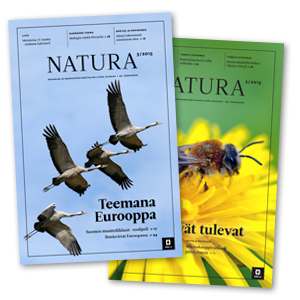“Eliökokoelma” = species collection
What is a species collection?
In the Finnish school curriculum, every high school student should compile a species collection. Traditionally the collection has been an herbarium, a collection of pressed and dried plants. Nowadays, the collection can be of any species group and is in most cases a photographic documentation of the species in their natural environment. The collection can be done also by using the online platform of the Finnish Biodiversity Information Facility, a member of the Global Biodiveristy Competition Facility.
Read more here: https://laji.fi/en and www.gbif.org
What and where to observe or collect?
The collection must consist of species seen in real life, in nature. The aim is to encourage youth to spend time in nature and to learn to observe biodiversity. They should learn to identify species in their environment. Therefore, it must be proven that the student was making the observations and taking the photographs themselves. There exists several websites and mobile apps to help you with species identification, and using traditional books is perfectly fine too.
Is it legal to collect species specimens?
The answer is no in most cases, but in some cases yes:
In Finland the Everyman’s Right grants access to nature and gives everyone the right to do several things in nature without explicitly asking for a permission if nature is not harmed in any way. The rights include the collection of:
– Edible berries and mushrooms
– Herbaceous plants (but not endangered species)
– Fishing with a simple rod
You are not allowed to collect parts of living trees, moss or lichen without a permission from a landowner. Do not disturb any animals when observing them. Read more on the Everyman’s Right from behind these links:
http://www.ym.fi/en-US/Latest_news/Publications/Brochures/Everymans_right(4484)
http://www.nationalparks.fi/hikinginfinland/rightsandregulations
How to collect a photographic species collection?
When taking photographs of a species it is essential to show the species so that it can be recognised with certainty. This means that there must be several photographs:
– A photo of the environment in which the species is living
– A full photo of the entire individual
– Close-up photos of the features that are important for the species identification, e.g. in plants the leaves or on mushrooms the structure beneath the cap
– Also, the teacher might request that in the photographs there should be a unique identifier for the collector, that will prove that they have taken the photograph themselves. This can be e.g. a piece of paper with the collector’s name or a small item such as a piece of Lego. The item will also act as a scale for the size of the species.
As for moving animals, placing the identifier or scale item next to them can be difficult and is therefore nor necessary in those cases. Also, animals such as birds might be seen from a longer distance and cannot and shouldn’t be photographed from too close.
There are instructions for making a plant collection, in Finnish. They are found here:
Video instructions: https://www.naturalehti.fi/2018/04/18/ohjevideot-kasvikokoelma/
Written instructions: https://www.naturalehti.fi/2017/04/15/nain-keraat-kuivaat-ja-kuvaat-kasveja/
Can I help my child in making the species collection?
In most schools this is even encouraged. You can go outdoors together to make the species observations and you can provide help in identifying species. Bear in mind though that the student must make the collection themselves and learn to identify species by themselves. If you are uncertain, ask more from you childs biology teacher.

